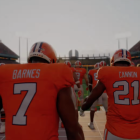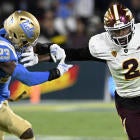OAKLAND, Calif. — The tortured NCAA analogy hung in the courtroom. Did the NCAA lawyer really just suggest whacking an opposing figure skater’s knee is similar to college players taking benefits that violate NCAA rules?
Welcome to the fifth day of the Ed O’Bannon vs. NCAA trial, a day when Tonya Harding was cited by an NCAA lawyer in questioning an O’Bannon economics expert. The comparison might have seemed like a fictitious episode out of “Seinfeld,” except that Jerry Seinfeld got cited by the same witness.
Friday will not be remembered as a momentous day in the O’Bannon case over whether players should be paid for use of their names, images and likenesses.
The O’Bannon plaintiffs tried to discredit the NCAA’s procompetitive justifications for not paying players. The NCAA tried to show the plaintiffs’ idea is for a professional model that would be unpopular to consumers.
“You’re actually hearing things like comparing Johnny Manziel and Tonya Harding,” O’Bannon attorney Bill Isaacson said afterward. “That’s now the level of defense. It's the same thing as saying that this sport is going to be less competitive or less popular when you have to stand up and compare Johnny Manziel and Tonya Harding."
During testimony, O’Bannon economic expert Daniel Rascher cited State" data-canon="Ohio Bobcats" data-type="SPORTS_OBJECT_TEAM" id="shortcode0">’s appearance in the 2011 Sugar Bowl and Manziel’s season-opening game in 2013 as examples of why paying players won’t hurt the product. Several Ohio State players were allowed to play after selling memorabilia for tattoos, and Manziel was suspended for a half after selling his autograph. In both games, TV ratings and fan interest remained high despite the public knowing that players had accepted benefits against NCAA rules, Rascher testified.
NCAA attorney Rohit Singla noted that the Harding-Nancy Kerrigan figure skating duel at the 1994 Olympics drew huge ratings, suggesting that unusual events (even if they're negative) can draw interest. Singla asked Rascher whether he was saying that because everyone watched Harding vs. Kerrigan that you should attack someone.
Rascher looked perplexed at the question. “That has nothing to do with amateurism,” replied Rascher, who earlier said winning due to players’ help is very important to fans beyond just “rooting for laundry, as Jerry Seinfeld said.”
There were actually a few more relevant moments Friday beyond the amusing color from the courtroom. What happened in Day 5 of the O’Bannon v. NCAA trial:
1. NCAA attacks Rascher’s possible payment model. Singla persistently went after a damages model Rascher had created if the players would have been allowed to collect 50 percent of past broadcast revenue. The damages class wasn’t certified by U.S. District Judge Claudia Wilken. But the model serves as a way for the NCAA to try to prove one of its procompetitive justifications for not paying players: competitive balance.
"The NCAA was always mad about the damages case," Isaacson said. "They're still mad about it."
Singla said that under Rascher’s model based off TV money, a Vanderbilt football player would receive $325,000 over five years, compared to $14,000 for a Memphis football player; and an Oregon State basketball player would get about $1 million, compared to $250,000 for an Idaho basketball player. Rascher said the conferences will pick a model that satisfies their needs, but also added he's uncertain what an injunction in this case would mean.
The NCAA’s argument: Better players will flock to the schools that pay more money. “I think coming out of here it’s becoming clearer and clearer that with their model we would become more professional than perhaps even some of the professional leagues,” NCAA chief legal officer Donald Remy said in an interview.
Rascher tried to show schools with the most money already generally attract the best players. He cited research from 2007-11 that out of 1,042 football recruits with offers from both Pac-12 and Sun Belt schools, only 20 chose the Sun Belt team. In men’s basketball, only nine out of 269 players chose the Sun Belt over the Pac-12.
The plaintiffs showed a quote from former Clemson president Jim Barker that said: “The playing field is not and has never been and never will be level.”
2. Gold-plated recruiting. Because players can’t be paid, Rascher said schools engage in what he calls “gold-plated recruiting.” That is, payments that might go to players instead land in lavish training facilities in order to woo recruits to the school.
Since schools are non-profits, they are incentivized to spend money in order to have revenues meets expenses, and some of that money is on “gold-plated recruiting,” Rascher said. The NCAA made the point that schools spend money on buildings for academics as recruiting tools, too.
Rascher contended there’s revenue sometimes undervalued in the NCAA financial reporting system for schools, such as concessions, sports camps, licensing, merchandising and parking. He also discussed types of revenues not counted by the NCAA, such as the value of media coverage, increased applicants, and more athletic donations on the university side.
Singla, the NCAA lawyer, attacked Rascher on some of his financial numbers, and in one example pointed out universities give money to athletics from a general fund. That is true, although some of the top-revenue programs that Rascher mentioned don’t get university subsidies.
In one of the more effective NCAA moves, Singla produced a statement from Cornell economics professor Robert Frank that said indirect effects of athletics success, such as applications and donations, are minimal. Frank wrote the information in a 2004 report for the Knight Commission.
“I disagree with this non-peer reviewed study,” Rascher said.
3. Would paying players resemble MLB and Olympics? Rascher discussed how there were concerns in the 1970s when Major League Baseball’s reserve clause ended and opened the market to players. He cited a 2004 poll in which 51 percent of the respondents said Olympians should be restricted to amateurs. Today, Rascher said, baseball and the Olympics are thriving with increased revenue.
The NCAA countered with an unusual exercise during cross examination. Singla cited Nielsen ratings showing declines for the Olympics as the public complained about the change in amateurism rules, and declines for the World Series as baseball fans complained about player salaries.
During redirect testimony, Isaacson produced a chart of all TV ratings that took into account how the entire industry has declined due to cable and the Internet. Singla objected that the chart had not been disclosed. Wilken allowed the new chart and agreed with the reasoning by Isaacson, who said, "I anticipated your cross."
4. Vanderbilt player begins testimony. The start of testimony from Chase Garnham, a former Vanderbilt linebacker who joined the lawsuit as an active player last summer, followed a similar pattern as other ex-players.
Due to football responsibilities, Garnham said Vanderbilt players could not schedule classes in a block from 3-7 p.m. each day except for Mondays. Garnham said he majored in human and organizational development because he didn’t know what he wanted to study and other football players found the schedule manageable. Garnham said conversations with academic advisors “certainly” impacted his major.
Garnham, who said he is unemployed after graduating last December, testified he spent about 40 hours a week on football activities in college. He said the only time he had no football responsibilities came during the one month when Vanderbilt was in-between head coaches. Vanderbilt had a team rule that if it lost a game, players were not allowed to go out and socialize, he said.
Remy, the NCAA chief legal officer, said athletes get the first choice of courses and have to fit classes into their schedules “just like every other student on campus.” Remy said he will be interested to hear more of Garnham's testimony, such as why he chose his major.
5. EA spreadsheet appears. For the first time, the much-discussed Electronic Arts Sports video game spreadsheet with player names publicly entered the O’Bannon case. EA employes said in depositions they created video-game avatars by using actual players’ characteristics and then removing the names.
On Friday, a spreadsheet for 2005-06 Alabama football players appeared on the court monitor. The spreadsheet showed actual names, jersey numbers and positions. Isaacson said other player characteristics were also on the spreadsheet but couldn’t be seen. Expect a lot more of this information when EA executive Joel Linzner testifies next Wednesday.
Garnham will finish his testimony Monday and be followed by Drexel professor Ellen Staurowsky to discuss the integration of academics with athletics. The NCAA could start its direct testimony by Monday or Tuesday. The NCAA’s planned early witnesses: Texas women’s athletic director Chris Plonsky, Stanford AD Bernard Muir, South Carolina president Harris Pastides, NCAA managing director of research Todd Petr, and NCAA economic expert James Heckman.
The plaintiffs want their cross examination of NCAA vice president of academic and membership affairs Kevin Lennon to go beyond the scope of his testimony, as was already agreed with NCAA president Mark Emmert. NCAA lawyer Glenn Pomerantz said that because of the plaintiffs' request the NCAA is still determining whether it will call Lennon.




















